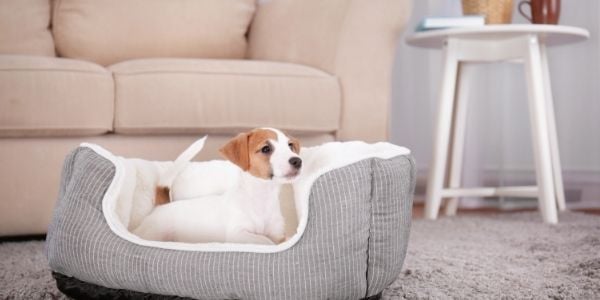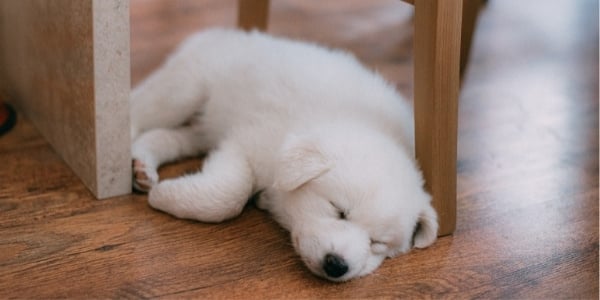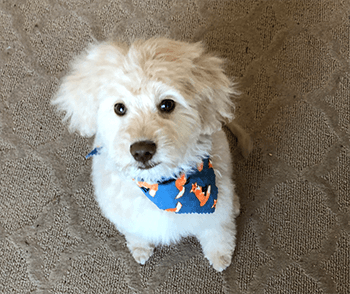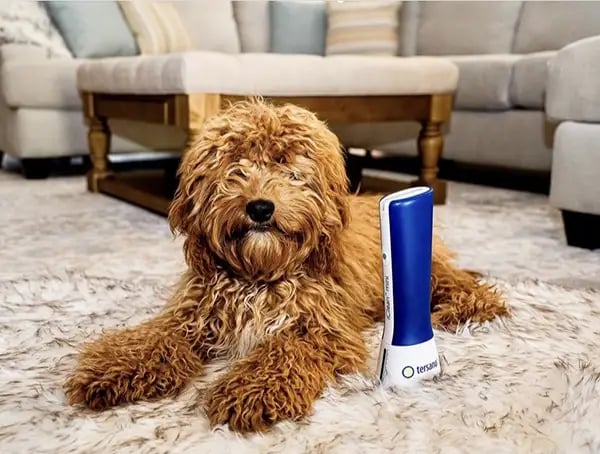 Puppy potty accidents are just no fun. Not only might you not find them until you step in them, but even once found they may encourage your pup to potty in the same spot unless cleaned up promptly and properly.
Puppy potty accidents are just no fun. Not only might you not find them until you step in them, but even once found they may encourage your pup to potty in the same spot unless cleaned up promptly and properly.
Like everything else about puppies, cleaning up their messes isn’t necessarily as straightforward as you might think.
Just because you can’t see or smell the mess any longer, doesn’t mean your dog can’t!
Below are the important steps and things to be aware of to best clean up dog pee and poop in your home.
A quick note about dog potty accidents themselves: Contrary to what some people might think, dogs don’t pee and poo inside out of spite or because they’re not smart.
Most Potty Accidents Happen for One of Three Reasons
- Your pup doesn’t yet understand where they’re supposed to go
- You’re not giving your pup ample and frequent enough opportunities to do their business outside
- Your dog has a medical problem (e.g., urinary tract infection, intestinal parasites or virus, or an anatomical defect, such as a patent urachus or ectopic ureter) that makes control difficult
The 3-Step Potty Accident Cleaning Process
It's important to follow this 3-step cleaning process, for your own health and safety, and for deterring future potty accidents. If your dog can smell a previous potty spot (which you probably can't), then your pup may consider that "spot" an approved potty zone for continued use.
These steps will work on hardwood, linoleum, tile, carpet, and most other flooring surfaces. Note that rugs and carpeting may require a little extra special attention and time to clean, especially if a stain has already been there for a while! (*Read about "blacklight" below for a cool trick to find old or dried urine stains.)1. Protect Your Paws
Before you start cleaning, make sure to wear gloves in order to protect yourself from potential urine and fecal pathogens, like the Leptospirosis bacteria that can be in dog pee and the Giardia or tapeworm parasites that can be in dog poop. All of these can be zoonotic, meaning they can cause problems in people.
2. Remove the Mess
Now remove the bulk of the mess. Use a dry rag or paper towels to soak up urine and use either a poo bag or paper towels to pick up poop. You can also use toilet paper to soak up urine or pick up poop, the advantage being that you can then flush those down the toilet*.
Once you’ve removed the bulk of the mess, you can follow up with towels or rags dampened with warm water to wipe or gently blot away (don't rub it in) the rest of the smaller residue.
*Note about flushing pet waste down the toilet: Whether or not you can or should flush your dog's poop isn't exactly a straightforward question. Some septic systems can handle pet poop, while others can't. Some states and municipalities allow for flushing of pet waste, while others don't.
Just some things to consider and look into before flushing your dog's poop down your toilet. A quick internet search or call to your local water and sewer department should provide you with the answer you need. Alternatively, you could install a specific pet waste septic system in your yard (so long as your soil has good natural drainage, i.e., isn't hard clay or hard-packed sand).

3. Use a Good Pee and Poop Odor Neutralizer for Dogs
Don’t reach for the carpet steamer or any old common household cleaner or carpet cleaner. Instead, grab a good enzymatic or bio-based product that’s manufactured specifically to truly neutralize the odor from dog pee and poop.
There’s an added bonus if the odor neutralizer also contains surfactants and other compounds that will clean the stain at the same time! It’s critically important that you truly neutralize and remove the odors from the pee or poop first before cleaning, shampooing, or steaming your floors and carpets.
Miss this odor-neutralizing step, and the lingering odor will keep your pup coming back for more!
I thought since I had hard floors that I was safe from this step. I simply wiped up the mess with a paper towel, then scrubbed the area with an all-purpose cleaner. Once my pup Mary Berry started going back to the same spot to do her business, I realized my mistake and purchased an odor neutralizer.
There are several enzymatic or bio-based pet odor neutralizers and cleaners on the market. We at Preventive Vet prefer the Urine Off or Unique Natural Products Pet Odor and Stain Eliminator products. Be sure to follow the label instructions for the proper use of whatever product you get.
The video below shows you how to use the Unique odor and stain remover effectively. One bottle makes 2.5 gallons of cleaner.
Unique's products are all made in the U.S. and are free from harmful ingredients like phthalates, chlorine, formaldehyde, and other additives that can be harmful to pets and people. They also have a professional strength Dog Odor & Stain Remover and one formulated for puppies.
Once you’ve fully neutralized the odor, it is a good idea to further disinfect the area, especially if children or immunocompromised individuals living in the household.
The reason is that your pup’s stool contains bacteria, such as Salmonella and E.coli, that can cause people to get sick. In fact, just one gram (.035 ounces) of poop contains about 23 million coliform bacteria!
One simple and easy way to do this, regardless of where the mess was, is to treat the area with Tersano's iClean mini.
We love the iClean mini because you can use it anywhere (even on fabric and furniture) and it's a triple threat: It cleans, sanitizes (kills up to 99.999% of germs), and deodorizes.
The iClean mini works by using electricity to change regular oxygen molecules (O2) into a special type of oxygen called ozone (O3). This ozone is then mixed with regular tap water to create a strong disinfectant.
When this ozone comes in contact with any germs or dirt, one of its oxygen molecules bonds to them and makes them harmless. What's left behind is just regular oxygen (O2) and water.
So, it's a safe and effective way to clean and disinfect your home without harsh chemicals!
It's been scientifically proven to be 50% more powerful than bleach but is completely safe if your pup decides to walk through, roll around in, or lick the freshly cleaned area.
Testing showed that the aqueous ozone reduced both Salmonella and E. coli by 99.999% in less than 5 minutes (and in 30 seconds on some surfaces).
This makes it the perfect cleaner for households with puppies, kids, immunocompromised family members, or germaphobes.
Use a Blacklight to Solve Pee Crimes
Know your dog has peed on your floors but can’t recall where? Got a spot that your pup keeps going back to and relieving themselves on? Here’s a nifty, “sciencey” hack to help you find old or otherwise hidden dog urine stains.The proteins in dog urine don’t just contribute to the odor of dog pee; they also — very conveniently — fluoresce (“glow”) when exposed to the beam of a blacklight.
Blacklight is a special category of ultraviolet light and is light in the 315-400 nanometers (nm) wavelength range. You can use this to your advantage with a simple blacklight flashlight.
This UV flashlight is inexpensive; however, the wavelength from this UV Blacklight Torch (365–370nm) is more effective — but it's a pricey gadget. (FYI: The greater the wavelength, the better visibility for fluorescing proteins in urine.)
Both of these lights will work, but the less expensive light will typically work best in a very dark room.
This video shows how to find cat urine, but the same applies to finding lingering dog urine stains.
Once you’ve identified where the old or residual urine stains are, use the odor (protein)-neutralizing and cleaners again, making sure to follow the label instructions carefully.
Mary Berry's Adventures in Potty Training
 We brought our miniature Goldendoodle Mary Berry home at 8 weeks and it was an adventure in potty training from the beginning.
We brought our miniature Goldendoodle Mary Berry home at 8 weeks and it was an adventure in potty training from the beginning.
Living in a fifth-floor apartment, we invested in an indoor grass patch to minimize our trips outside in the middle of the night.
She took to the grass patch very quickly, but now that she’s 4 months and able to hold her bladder for longer, we’re transitioning her to going potty outside all the time.
Training her to go outside rather than inside has been a challenge, but with frequent potty breaks, treats, and praise, we are steadily seeing fewer accidents to clean up.
One Final Piece of ‘Business’
Again, if your puppy is having lots of accidents, there’s a good chance your potty training process isn’t what it needs to be and/or that your pup could have a medical problem.
If your pup is a frequent offender, check out our article to get some ideas of what could be causing their potty accidents and how you can best help your dog.
Stop potty accidents and get help with house training in our Puppy Essentials: Potty Training Workshop
Includes unlimited access to self-paced training sessions, videos, downloadable resources, and more — all for only $9!





